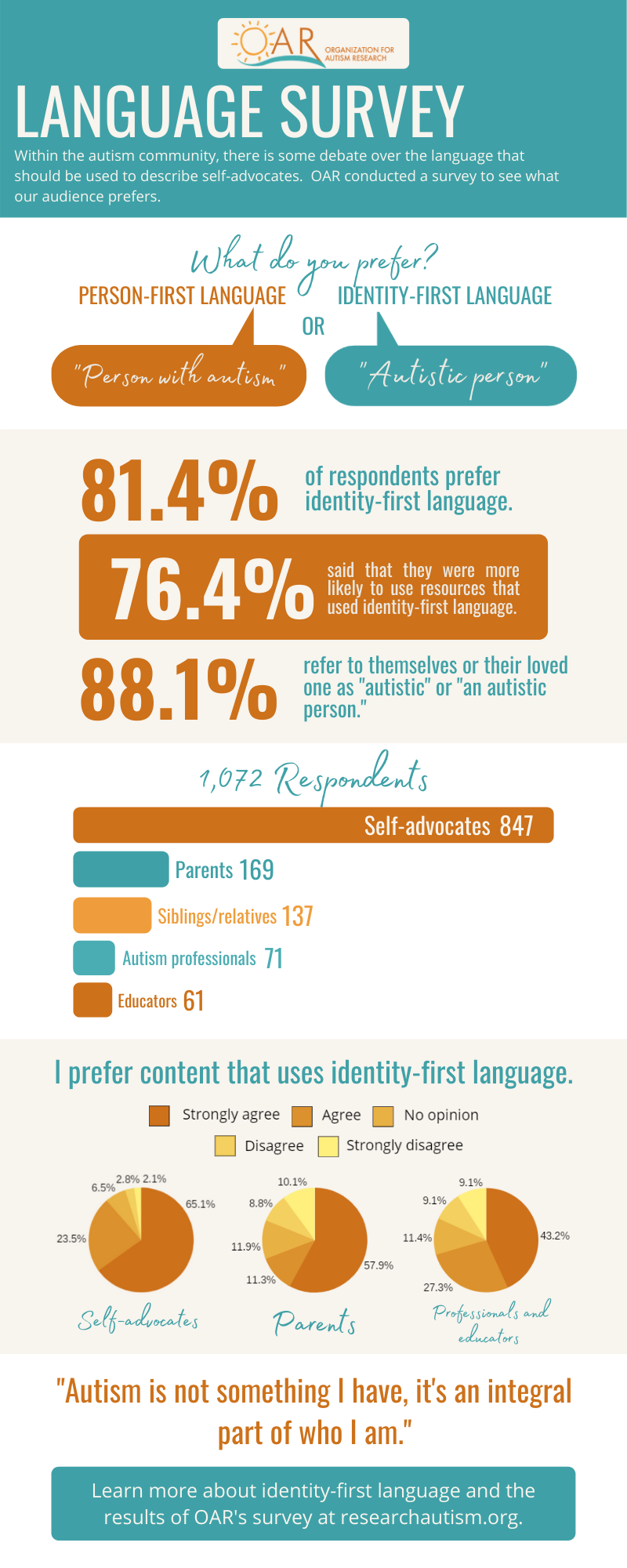1,000 People Surveyed, Survey Says…
September 30, 2020
By: Organization for Autism Research
Categories: Families, OAR News, Self-Advocates
For as long as the autism and disability communities have existed, they have engaged in a robust conversation about labels. This ongoing conversation has been tied to deeper conversations about disabled people’s worth, needs, and rights. When OAR was founded in 2001, person-first language, which places the personhood of the individual before their disability, was the unquestioned standard. Some examples of person-first language are:
Person-first language was preferred within the autism community in order to avoid the implication that a person was defined by their autism. Its intent was to have people see the person, not the disability, first.
In recent years there has been a growing push within the autism community, most notably among self-advocates, to use identity-first language. Some examples of identity-first language for autism are:
The rationale for this language is that a person cannot be separated from their autism, nor would they want to be. Autism is one of many qualities that a person can have; just as someone can be strong or smart, they can be autistic.
In the past few years, OAR has become increasingly aware of these differing points of view. To better understand which labels the majority of our audience prefers, we conducted a survey. We received an incredible response: over 1,000 people participated in our survey, including more than 800 self-advocates. Not surprisingly, the survey group overwhelmingly preferred identity-first language.
 What was interesting in the more limited response from OAR’s more established audience, parents and autism professionals, was they were more relaxed and flexible about their language preference than their predecessors were 20 years ago, when person-first language was the standard.
What was interesting in the more limited response from OAR’s more established audience, parents and autism professionals, was they were more relaxed and flexible about their language preference than their predecessors were 20 years ago, when person-first language was the standard.
Of the more than 800 self-advocates who completed the survey, 88.6% indicated a preference for identity-first language. When asked to elaborate, they responded with insights such as:
Parents, siblings, relatives, educators, and autism professionals echoed these sentiments:
This survey confirmed what OAR had suspected. Times and attitudes have changed considerably in this regard. There is a clear preference for identity-first language among our audience. In response, OAR has decided to adopt identity-first language as its default: moving forward, when referring to autistic people in general, we will use identity-first language.
We acknowledge that there is no universal label that works for everyone. Many people prefer person-first language or other ways of speaking about autism, including terms like “neurodivergent,” “autist,” or “aspie.” As we have always done, we will respect the preferences of individuals and refer to them with their preferred language. In our continued mission to best support the community we serve, we hope to continue to be responsive to the opinions of autistic individuals, their families, and their loved ones, as well as those of the teachers and autism professionals who serve the community.